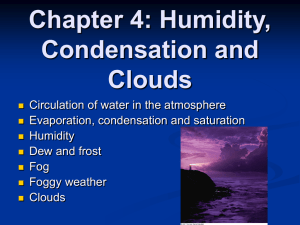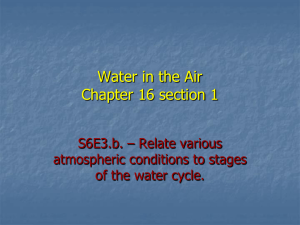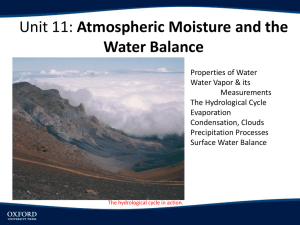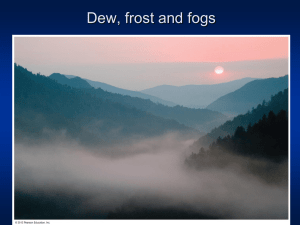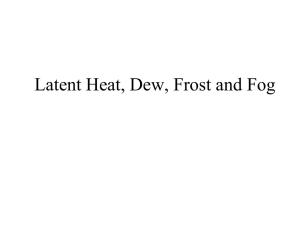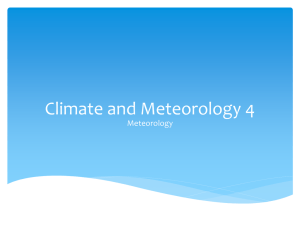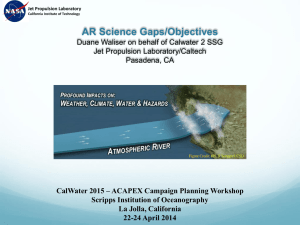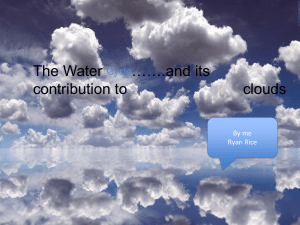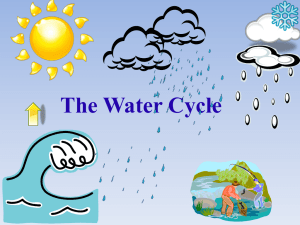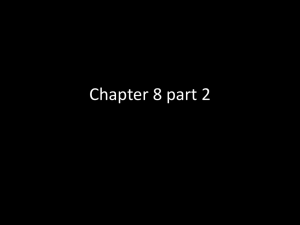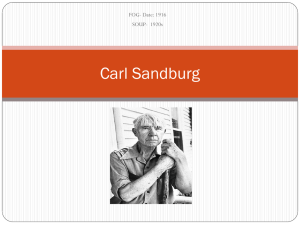Class #3: Humidity, condensation, and clouds
advertisement
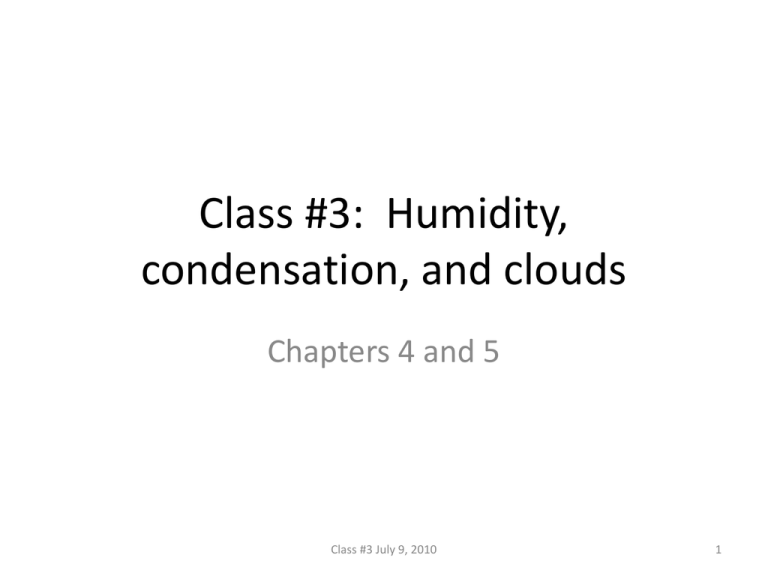
Class #3: Humidity, condensation, and clouds Chapters 4 and 5 Class #3 July 9, 2010 1 Chapter 4 Atmospheric Humidity Class #3 July 9, 2010 2 Circulation of Water in the Atmosphere • A general definition of humidity is the amount of water vapor in the air. • Remember, humidity is not constant through time or space, there is constant circulation of water through the hydrologic cycle. Class #3 July 9, 2010 3 Class #3 July 9, 2010 4 Class #3 July 9, 2010 Stepped Art 5 Fig. 4-1, p. 90 Class #3 July 9, 2010 6 Fig. 4-2, p. 91 The Many Phases of Water • Phase is related to molecular motion, an increase or decrease in motion creates a phase change. • Ice is the coolest/slowest phase • Water vapor is the warmest/fastest phase Class #3 July 9, 2010 7 Class #3 July 9, 2010 8 Evaporation, Condensation, & Saturation • Evaporation is the change of liquid into a gas a requires heat. • Condensation is the change of a gas into a liquid and releases heat. – Condensation nuclei • Saturation is an equilibrium condition in which for each molecule that evaporates, one condenses. Class #3 July 9, 2010 9 Class #3 July 9, 2010 10 Class #3 July 9, 2010 11 Humidity • Any of a number of ways of specifying the amount of water vapor in the air. • Absolute humidity: mass of water vapor/volume of air – Water vapor density – Not commonly used due to frequent change of volume Class #3 July 9, 2010 12 Class #3 July 9, 2010 13 Class #3 July 9, 2010 14 Humidity • Specific Humidity: mass of water vapor/mass of air • Mixing ratio: mass of water vapor/mass of dry air • Neither measurement changes with volume, must add or subtract water vapor. Class #3 July 9, 2010 15 Class #3 July 9, 2010 16 Class #3 July 9, 2010 17 Humidity • Vapor pressure: the pressure exerted by water vapor molecules in an air parcel (Dalton’s Law of Partial Pressure) – Fraction of total vapor pressure (1% or so) – More water molecules = high vapor pressure • Saturation vapor pressure: the vapor pressure at which an air parcel will be saturated, changes with temperature Class #3 July 9, 2010 18 Class #3 July 9, 2010 19 Humidity • Special Topic: Vapor Pressure & Boiling – Once water boils it requires more energy to increase temperature. – Water boils at a low temperature in the mountains and thus needs more energy and time to cook items as compared to sea level. Class #3 July 9, 2010 20 Humidity • Relative Humidity: (actual water vapor/saturation water vapor)*100 – RH can be changed two ways: • Change vapor content • Change saturation – Decrease temperature causes an increase in relative humidity (inverse relationship). Class #3 July 9, 2010 21 Class #3 July 9, 2010 22 Humidity • Relative Humidity and Dew Point – Dew point is the temperature at which saturation occurs – Cool air parcel to dew point and liquid water condenses – A good measure of actual water vapor content – Relative humidity indicates how close to saturation, dew point indicates the amount of water vapor Class #3 July 9, 2010 23 Class #3 July 9, 2010 24 Class #3 July 9, 2010 25 Fig. 4-13, p. 98 Class #3 July 9, 2010 26 Fig. 4-13, p. 98 Class #3 July 9, 2010 27 Fig. 4-13, p. 98 Class #3 July 9, 2010 28 Fig. 4-13, p. 98 Class #3 July 9, 2010 29 Class #3 July 9, 2010 30 Class #3 July 9, 2010 31 Class #3 July 9, 2010 32 Class #3 July 9, 2010 33 Fig. 4-15a, p. 100 Class #3 July 9, 2010 34 Fig. 4-15b, p. 100 Humidity • Relative Humidity in the Home – Due to an increase in temperature in a heated home there is a decrease in relative humidity, causing more evaporation from body, plants, etc • Humidifier, chapped lips – Swamp cooler Class #3 July 9, 2010 35 Class #3 July 9, 2010 36 Humidity • Relative humidity & human comfort – “It’s not the heat, it’s the humidity.” – High relative humidity equates to less evaporative cooling. – Sweat cannot evaporate and cool the body – Wet bulb temperature – Heat Index Class #3 July 9, 2010 37 Class #3 July 9, 2010 38 Humidity • Special Topic: Heavier humid air – Due to the molecular weight of water as compared to nitrogen, humid air is lighter than dry air. – Baseball announcers are incorrect. Class #3 July 9, 2010 39 Humidity • Measuring humidity – Sling psychrometer – Hygrometer Class #3 July 9, 2010 40 Class #3 July 9, 2010 41 Chapter 5 Condensation: DEW, Fog, & clouds Class #3 July 9, 2010 42 The Formation of Dew & Frost • Dew forms on objects near the ground surface when they cool below the dew point temperature. – More likely on clear nights due to increased radiative cooling • White frost forms when temperature cools below the dew point and the dew point is below 0°C Class #3 July 9, 2010 43 Class #3 July 9, 2010 44 Class #3 July 9, 2010 45 Condensation Nuclei • Particles suspended in the air that around which water condenses or freezes. – Hydrophobic/hygroscopic Class #3 July 9, 2010 46 Class #3 July 9, 2010 47 Table 5-1, p. 113 Class #3 July 9, 2010 48 Class #3 July 9, 2010 49 Haze • Dry condensation nuclei (above dew point) reflect and scatter sunlight creating blueish haze. • Wet condensation nuclei (75% relative humidity) reflect and scatter sunlight creating grayish or white haze. Class #3 July 9, 2010 50 Class #3 July 9, 2010 51 Fig. 5-4, p. 114 Fog • Saturation reached condensation forms a cloud near the ground • Radiation fog: ground cools through conduction and radiation; ground fog – Valley fog created by cold air drainage – High inversion fog Class #3 July 9, 2010 52 Class #3 July 9, 2010 53 Class #3 July 9, 2010 54 Fog • Advection Fog: warm moist fog moves horizontally (advects) over a cool surface. – Summer fog on the Pacific coast • Observation: Headlands – Air converges and rises over headlands forming fog as compared to lower elevation beaches. Class #3 July 9, 2010 55 Class #3 July 9, 2010 56 Class #3 July 9, 2010 57 Fog • Upslope Fog: moist air flows up an orographic barrier – East side of the Rockies • Evaporation Fog: – Warm moist surface provides enough moisture to saturate a dry air parcel; short lived • Steam fog • Breath in winter Class #3 July 9, 2010 58 Class #3 July 9, 2010 59 Class #3 July 9, 2010 60 Foggy Weather • In general fog not common for most location in the US. However several areas do exist with a high frequency of fog. Two causes: – Elevation – Ocean currents Class #3 July 9, 2010 61 Class #3 July 9, 2010 62 Foggy Weather • Environmental Issue: Fog dispersal – Mix air with air craft or fans – Introduce large particle into air to reduce total number of cloud droplets. – Use dry ice to lower temperature below freezing. Class #3 July 9, 2010 63 Clouds • Classification of clouds: use Latin words to describe height and appearance. • Factors described – Height: low, mid, high, vertical – Appearance: shape, density, color Class #3 July 9, 2010 64 Class #3 July 9, 2010 65 Class #3 July 9, 2010 66 Class #3 July 9, 2010 67 Class #3 July 9, 2010 68 Class #3 July 9, 2010 69 Class #3 July 9, 2010 70 Class #3 July 9, 2010 71 Class #3 July 9, 2010 72 Class #3 July 9, 2010 73 Class #3 July 9, 2010 74 Class #3 July 9, 2010 75 Class #3 July 9, 2010 76 Class #3 July 9, 2010 77 Class #3 July 9, 2010 78 Some Unusual Clouds • Not all clouds can be placed into the ten basic cloud forms. • Unique atmospheric processes and environmental conditions create dramatic and exotic clouds. • Unusual clouds and weather balloons often cause of UFO reports. Class #3 July 9, 2010 79 Class #3 July 9, 2010 80 Class #3 July 9, 2010 81 Class #3 July 9, 2010 82 Fig. 5-26, p. 130 Class #3 July 9, 2010 83 Fig. 5-27, p. 130 Class #3 July 9, 2010 84 Fig. 5-28, p. 130 Class #3 July 9, 2010 85 Fig. 5-29, p. 130 Class #3 July 9, 2010 86 Fig. 5-30, p. 131 Class #3 July 9, 2010 87 Fig. 5-31, p. 131 Cloud Observations • Sky conditions: cloud coverage divided into eighths and each amount associated with term such as scattered clouds. • Observations: cloud ceilings – Ceilometer used at airports to determine height from clouds by light or laser striking clouds and then amount and speed of reflected light recorded. Class #3 July 9, 2010 88 Class #3 July 9, 2010 89 Fig. 5, p. 132 Class #3 July 9, 2010 90 Cloud Observations • Satellite Observations – Geostationary, polar orbiting – Visible light provides a black and white picture of clouds – Infrared approximates cloud temperature which infers height – Satellites measure many other variables: sea surface temperatures, ozone, upper level features, snow cover, land cover Class #3 July 9, 2010 91 Class #3 July 9, 2010 92 Class #3 July 9, 2010 93 Class #3 July 9, 2010 94
